Table of Contents
開く- Introduction
- Transmission of rice farming technology and birth of a state
- Manorial system and Samurai (warrior) society
- Technology and New Paddy Field Development during the Edo period
- Modernization and land consolidation (Meiji period (1868-1912))4)
- Rice price hike and rice riot (Taisho period)
- Showa depression and national projects (From Showa period (1926-1989) to World War II)
- Measures for food production increase after the World War II (1945~54)
- Reducing disparities between rural and urban sectors and infrastructural improvement (1955~1964)
- Surplus of rice and multiple uses of paddy fields (1965~)
- Globalization and fostering personnel (Heisei Period)
- Heisei, Reiwa Periods and Further Ahead
1. Introduction
As shown in Figure 1, the population of Japan has gradually increased from the period of rice farming technology transmission to the modern period in pace with the expansion of agricultural land area, which is the foundation for food supply. In the early Edo period, agricultural land area increased significantly and so did the population. After the Meiji period, it rapidly increased further, which resulted in another population explosion. However, around 1955, agricultural land area peaked and started to rapidly decrease. The population increase also reached its limit and now Japan has entered into a period of decreasing population for the first time in history. In this “Land Chapter”, the history of Japanese agricultural land which has supported our lives from the prehistoric periods is reviewed and future prospects for agricultural land are analyzed.
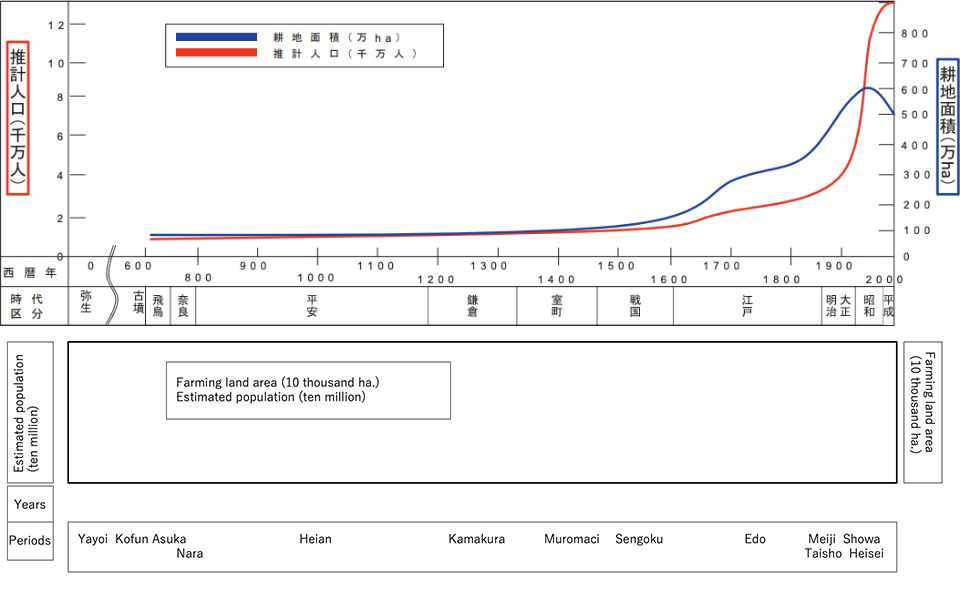
2. Transmission of rice farming technology and birth of a state
It is said that around the 10th century B.C.E., rice farming technology was brought into the coastal areas of the Genkai-nada Sea along the northern part of Kyushu Island, Japan. During the beginning of rice farming in Japan, paddy fields were constructed in back marshes at the downstream of a river or swampy lands in valleys (Figure 2) through a village’s collaborative work. During the Yayoi period (300BCE – 300CE), rice farming technology extended north, up to Aomori Prefecture (Figure 3). With iron farming tools (Figure 4) introduced during the late Yayoi period channel and pond construction as well as new paddy field development became easy. Rice farming culture, represented by Toro archeological site, had been born (around 1st century C.E.).
In the meantime, while production capacity expanded with the progress of rice farming, disparity of wealth became visible among villages, and an ancient state gradually formed with the unification of powerful groups (Kuni) under ruling conditions (around 4th century C.E.). The tenth emperor, Sujin, during the Kofun period(300CE-538CE) is believed to have said, “Agriculture is the foundation of a country. Water in paddy fields is scarce, so open up ponds and channels so that people can make affordable living.” (Nihonshoki (Chronicles of Japan)). Ancient tombs (Figure 5) found widely across the Yamato plain and Nara valley are evidence of powerful rulers. They are now considered to have been constructed not by compulsory mobilization of people but collaborative works of people under a ruler, for utilizing the moat also for an irrigation pond1).
After the Taika Reform in 645, a centralized governing system of public land for public use was introduced that imitated the legal code system of Tang, China, and made improvements to farming lands and irrigation systems along subdivided lands laid out in a grid pattern based on the Jyori System (ancient system of land allocation). Males of more than 6 years of age were allocated 2 Dan (about 0.24 ha.) of Kubunden (allotted rice field), females received 2/3 of a males’ land, and 3% of production from rice fields was charged as a tax (Handen Shuju System (rice field allotment system)). The unit of 1 Dan (1 Tan) was equivalent to the rice field area that could produce about 1 Koku (1,000 Gou or about 150kg) of rice, which would support one adult for one year in those days (7~8th century).
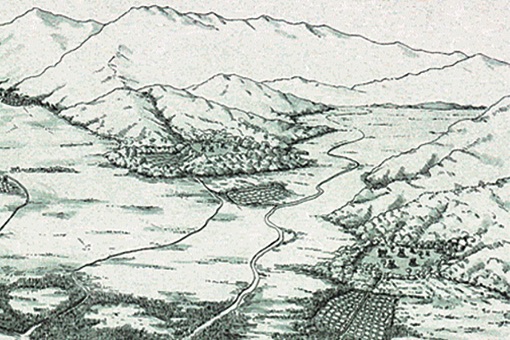
(Citation: Daichi eno Kokuin, p.64)
-Paddy fields had initially been located in semi lowland at an entrance of valley-
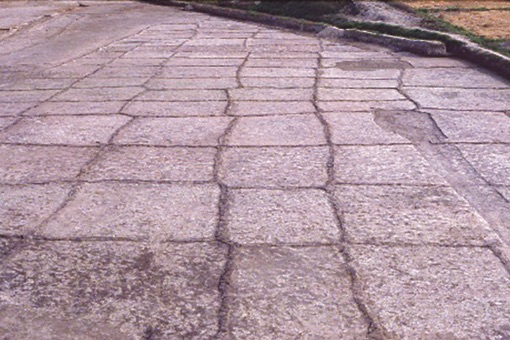
(Provision: Inakadate Education Board)
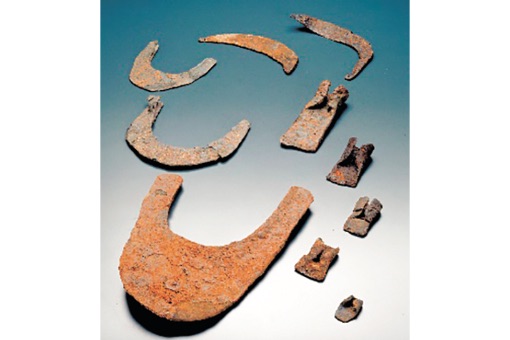
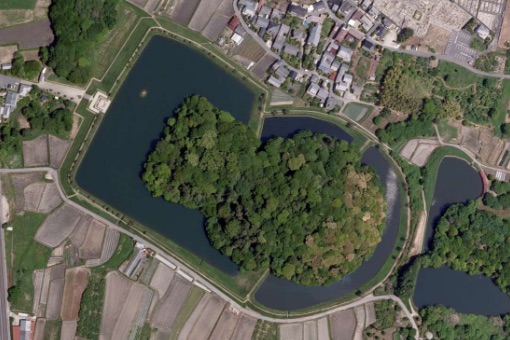
(Source: Website of Geographical Survey Institute)
- Even at present, irrigation water is provided to 3 branches from 3 moats-
3. Manorial system and Samurai (warrior) society
With population growth, the agricultural land for continuing the rice field allotment system became deficient, and the state enacted the Sanze Isshin Hou (the law to assure the possession of new reclaimed land for three generations) in 723 and Einen Shizai Hou (the law permitting the permanent ownership of newly reclaimed land) in 743 to encourage reclaiming new land. By these measures, permanent private ownership of newly reclaimed land was officially recognized, and the system of public land for public use collapsed. Aristocrats and shrines/temples started to expand private land into Shoen (manors). The manorial system existed for the following 800 years. Taxation rights and profit making on manors was complicated, and farmers were sometimes forced to repeatedly pay taxes by landowners.
Around the 10th century, warriors started to gain power as manorial guards and owners of reclaimed lands thus emerging as a ruling class. Yoritomo Minamoto established the feudal system (Goon to Houkou: reward and service) and promoted land and water development after positioning a Shugo (governor) for each province and a Jito (estate steward) for each manor/public territory.
During the Muromachi period (1333-1573), Shugo started to control manors and public territories, thus becoming Shugo Daimyo (territorial lord as provincial constable), who made master-servant relationships with powerful local clans. After the Onin War in 1467, the Sengoku (civil war) period (1467-1615) started, and manors in the frontier were invaded by warriors. From around the 14th century, farmers united to organize autonomous village organizations called “Sou”, which took responsibility for constructing and maintaining irrigation facilities and managing Iriaichi (common land.) They also formed a prototype of a management system unique to Japan.
In those days, the production capacity of rice was the economy’s base, and warlords actively promoted new paddy field development on a basin scale. Improvements to the Kamanashigawa and Fuefukigawa rivers in Koushyu province by the Takeda clan, the Shinanogawa river in Echigo province by the Uesugi clan, and the Ohtagawa river in Aki province by the Mouri clan can be listed as examples.
Hideyoshi Toyotomi conducted the Taikou Kenchi (nationwide land cadastral) in 1594 after unifying the country (Figure 6) and adjusted the standard of land productivity for imposing taxes and awarding territory. With these adjustments, all lands were allocated to specific territorial lords under the principle of “one cultivated land for one cultivator”. As such the manorial system which started in the Nara period came to an end.
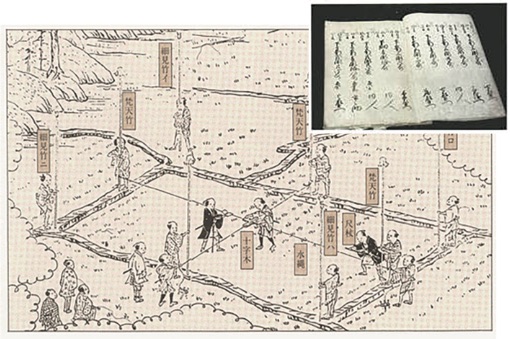
(Citation: Daichi eno Kokuin, p.171 “Tokugawa Bakufu Kenchi Youryaku”)
4. Technology and New Paddy Field Development during the Edo period
The Tokugawa Shogunate established a social order through territorial control by the Bakuhan Taisei (domain and Shogunate System) and the solid class system (Heinou Bunri: separation of farmers and warriors). By assigning specific yields of rice to the land based on rice production, rice became the Shogunate’s financial base. In the village, farmers were organized in units known as Gonin Gumi (5-household group), who appointed a Nanushi (it is called Shoya in Western Japan and Kimoiri in Tohoku region) as their leader to govern the village through mutual aid and monitoring to pay taxes and impose labor contributions based on Murauke Seido (system of village-wide, collective responsibility for tax payment).
During the Edo period, securing rice production and supply was the policy foundation, and large-scale new paddy field development progressed all over Japan along with the progress of land technology. In the Kanto Plain, rerouting of the Tonegawa River and reclamation of marsh land were conducted in the early 17th century with techniques called the Kanto Ryu (Kanto school). Furthermore, Yasobei Izawa, who was invited from Kishyu Domain to Edo by the 8th Shogun Yoshimune in 1722, adopted the Kishyu Ryu techniques to develop the Minuma Dai Yousui irrigation system (Figure 7.) He did this by abolishing overflow embankments and Kasumi embankments of the Kanto school while reinforcing the river channel by solid embankments and bank protections in the river downstream. Shipping canals were also developed and a transport system linking the Kanto and Tohoku regions was established.
In western Japan, uncultivated land was rarely available and coastal zone development by sea land reclamation was actively promoted along places such as the Yatsushiro Plain, Kojima Bay and the Ariake Sea (Figure 8).
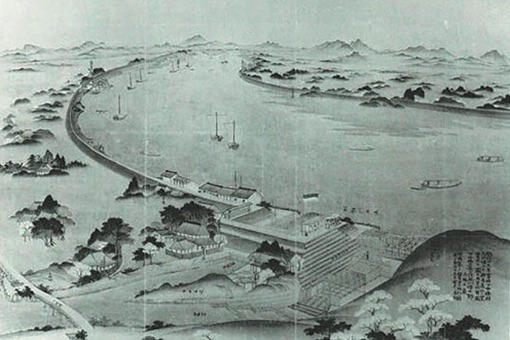
(Citation: Daichi eno Kokuin, p.142)
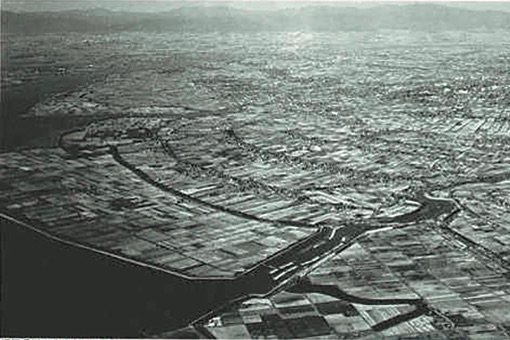
(Citation: Daichi eno Kokuin, p.98)
-New reclaimed lands constructed one after another like fish scales can be observed-
Through land developments during the Edo period, the cultivated land area of Japan doubled from about 1.5 million ha. during the Toyotomi period to about 3 million ha. over the 100 years of the early Edo period. Likewise, the population of 12.27 million at the start of the Edo period in 1603 increased 2.5 times to 31.28 million by the Kyoho Reform period (1716-1745).
Since then, three great famines occurred during the Edo Period, namely the Kyoho (1732), the Tenmei (1782-1787) and the Tempo (1833-1839). The fundamental cause of these famines was crop failure by natural disasters, but market mechanisms further aggravated conditions2)3). In the case of the Tenmei Famine that mainly devastated the Tohoku region, farmers were impoverished by poor crops caused by yamase (cold damage). Tsugaru domain and Sendai domain, which were under financial difficulties because of debts to wealthy urban merchants, imposed heavier rice collection taxes on these farmers and transported the rice to Edo. With such measures, conditions of “starvation emigration” resulted, and around 0.5 million people (in the case of Tsugaru domain around 1/3 of its population) are estimated to have been victimized, manifesting a landscape reminiscent of hell. The Great Famine of Tempo triggered a rebellion by Heihachiro Oshio, but the underlying causes of the rebellion was the transport of rice to Edo by Machibugyo (town magistrate) and the buy-up of rice by wealthy merchants for profits in the midst of famine.
5. Modernization and land consolidation (Meiji period (1868-1912))4)
The Meiji government conducted the Chiso Kaisei (land tax reform) from 1873 to 1879 to establish a system of private land ownership and a financial base by allowing free land trading and shifting land taxes from rice to cash payment. Introduction of modern technologies including the steam pump in the Asaka Sosui Project and oil engines (Figure 9) during the Taisho period (1912-1926) brought about a revolution in water use, which was followed by the appearance of fossil fuels for allowing large scale construction.
Toshimichi Okubo and Masayoshi Matsukata of the Meiji government implemented land reclamation projects in Asaka waste land and Hokkaido by setting up the Shizoku Jusan Seido (relief work measure for the descendants of samurai system) to encourage feudal warriors who lost their positions by the Haihan Chiken (abolition of feudal domains and establishment of prefectures) to farm and settle through reclamation and settlement measures. The centralized government could concentrate funds for prioritized activities, and large-scale constructions including the National Asaka Sosui Irrigation Project (Figure 10) were initiated.
Private land ownership provided an incentive for production, and landowners initiated land consolidations called Denku Kaisei (revision of rice fields). Field ridge improvement by the Shizuoka method during the Meiji 20s (1887~1896) and western-style land consolidation (Figure 11) implemented by Kyubei Takata of Kaga in 1888 were typical Denku Kaisei, which standardized plot sizes by a 10 a land readjustment suitable for animal traction farming including horses.
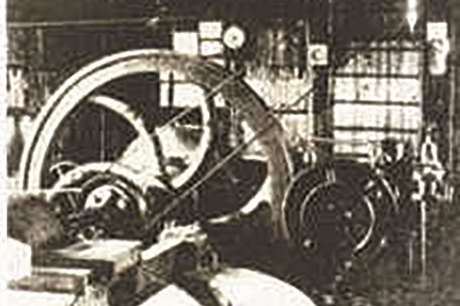
(Citation: Daichi eno Kokuin, p.107)
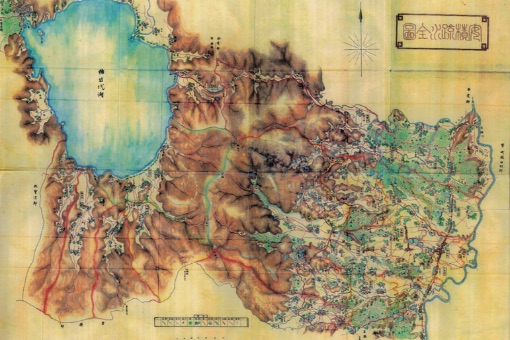
(Provision: Asaka Sosui Land Improvement District)
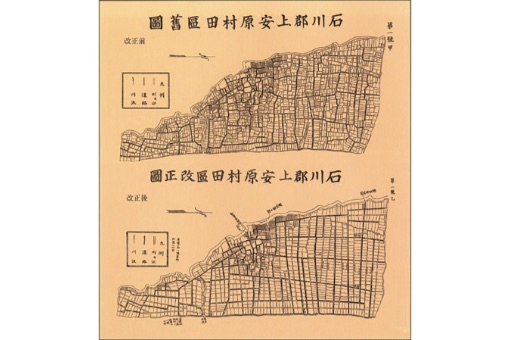
(Citation: Suido no Ishizue “Kokudo wo Souzoushita Hitobito” (Foudantion of Water and Land Development “People who developed the land”))
Tsuneaki Sakou who returned from Germany (Prussia), described in his publication “Tochi Seiri Ron" (theory of land consolidation) that the benefits of conducting land consolidation were significant and in particular land consolidation projects in Germany were conducted with the support of over 50 % of landowners due to their law5). The common practice of rice field plot revision in Japan and the land consolidation law system of Germany were merged to enact the Land Consolidation Act in 1899, and the system of implementing projects was established with the consent of more than two thirds of landowners. The Kounosu method, named after the land consolidation project, conducted in Saitama Prefecture in 1902, became the model for land consolidation because it resulted in less non-arable land compared to the Ishikawa method. Hidesaburo Ueno opened a course on Nougyou Doboku Gaku (Irrigation, Drainage, and Reclamation Engineering) at Tokyo Imperial University in 1900 and organized a land consolidation study group in 1907.
Arable land readjustment in an early stage was conducted to reduce labor cost by modernizing agriculture, but after the Russo-Japanese War (1904-1905) growing demand for an increase in land productivity arose due to the shortage of rice production capacity and the increase of rice import. Thus in 1905, the Land Consolidation Act was revised to include irrigation and drainage as one of the project's works. The act was fully revised in 1909 to further include reclamation, land category conversion, management of constructed facilities, and subsurface drainage works to enrich project contents. Through modernization of agricultural practices in the Meiji Period's 40 or so years, about 0.67 million ha. land was reclaimed and the population of 34.8 million in 1872 increased to more than 50 million by 1912.
6. Rice price hike and rice riot (Taisho period)
With the outbreak of World WarI (1914~1918), industries boomed and people migrated from rural to urban areas. In rural areas, sericulture prospered, and family income increased, which prompted the food habit to shift from wheat/Japanese millet to rice. In addition to the increase demand for rice, merchants bought up rice for speculation after the dispatch of troops to Siberia, and the price of rice soared significantly, resulting in the destruction, and burning of the residences/stores of rice merchants by workers (rice riots).
After these events, the government enacted the Rice Act in 1921 to adjust the demand and supply of rice. In 1919, they also enacted the Reclamation Support Act to provide interest subsidies for subsurface drainage work and reclamation financing. From 1923, fifty percent subsidy was provided by the central government to irrigation and drainage improvement projects of prefectural governments with more than 500 ha. beneficiary areas. This became the first case of the central government investing directly and significantly in land improvement projects.
7. Showa depression and national projects (From Showa period (1926-1989) to World War II)
In 1929, the international price of silk dropped sharply due to the Great Depression, triggering the Showa Depression (also called agricultural depression), which saw the prices of other agricultural products also drop sharply in a chain reaction. Furthermore, in 1931, the Tohoku and Hokkaido regions suffered from serious cold damages, and operations and livelihoods of small-scale farmers came to a deadlock. Tenancy disputes increased and persisted, and the sale of daughters and undernourished children became a social problem. It is reported that the number of daughters sold reached more than 40 thousand nationwide, but mainly from the Tohoku region.
In the face of such difficulties in rural areas, the government actively promoted public investment projects called Kyunou Doboku Jigyou (projects to help small farmers through civil engineering works). This is one of the innovative examples of utilizing land improvement projects as a relief measure against unemployment. In particular, the subsidy rate for subsurface drainage work was increased from 30 to 50 percent because there were many arable land areas with poor drainage. In 1929, the study group for arable land readjustment was reorganized to establish the Japanese Society of Irrigation, Drainage and Reclamation Engineering (now known as the Japanese Society of Irrigation, Drainage and Rural Engineering).
Small scale land reclamation progressed by the Reclamation Support Act, but there were about 0.4 million ha. of land suitable for large scale reclamation (more than 500 ha.) nationwide. To cope with such large-scale development, a large-scale reclamation plan was drafted in 1927, and the first national land reclamation project, Oguraike Land Reclamation, started in 1933 (Figure 12). Many national reclamation projects were initiated; such as at Sanbongihara (Aomori Prefecture) and Tazawa Sosui (Akita Prefecture) in 1933, followed by Kawaminamibaru (Miyazaki Prefecture in 1939), Yabukihara (Fukushima Prefecture in 1940) and Shouwairo (Oita Prefecture in 1941).
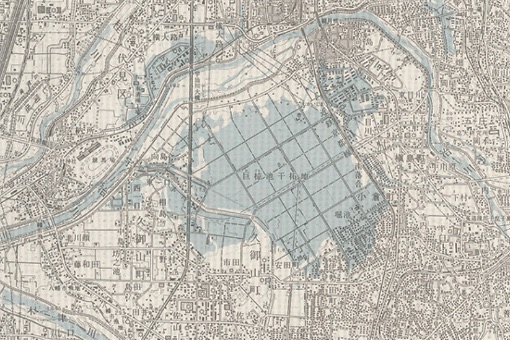
(Citation: Daichi eno Kokuin, p.109)
-Old pond (blue color of about 800 ha.) was overlaid on the current map-
In addition to an increase in food production, improvements in public health contributed to decreasing the mortality rate (in particular infant and neonatal mortality rate) from the Taisho period onward, and the total population of Japan reached about 70 million in 1935.
When the Sino-Japanese War (1937~) started, food shortages became serious, and a 10-year plan for strengthening major food self-sufficiency was adopted in 1940. In 1941, an Agricultural Land Development Act was enacted and guidelines for projects of a diversified nature including land reclamation and irrigation/drainage improvement were unified to allow the implementation of national projects over three thousand ha. (with project costs of over 1 million yen) by the Agricultural Land Development Agency.
The Pacific War started in 1941, and during the war period the food distribution system collapsed, and the dietary lives of people were under extreme difficulty. To reduce the dependence on foreign imported rice, increased production of potatoes and coarse grains were promoted on an ad hoc basis in June of 1943 as the first emergency measure for food production increase. In August of the same year, the second emergency measure for food production increase was adopted to implement small scale land improvements for increasing land productivity in cooperation with students and non-farmers, however, large scale reclamation projects were postponed because they required a large volume of materials and equipment.
8. Measures for food production increase after the World War II (1945~54)
After World War II, about 6 million people returned from overseas to devastated national land. Furthermore, due to a poor rice crop in 1945 food rations could not be distributed in large cities, and people suffered from starvation. Before the arrival of winter in November 1945, a national gathering against starvation death measures was organized in Hibiya Park in Tokyo. During this time, urban residents had to travel to rural areas by train or go to black markets in the city to obtain food at unreasonable prices.
The government initiated an emergency reclamation project in 1945 for an urgent implementation of food production increase and unemployment measures. The plan included new land reclamation of 1.55 million ha. over 5 years, 0.1 million ha. of reclamation by drainage over 6 years and implementation of 2.1 million ha. of land improvements for already cultivated land.
Through land reforms starting in 1946, land was expropriated from landowners over a 4-year period and allocated to tenant farmers to create owner-cultivators as major stakeholders. A Land Improvement Act enacted in 1949 established basic procedures for infrastructure improvements to national/prefectural projects and other actions, including democratic management of land improvement districts, project implementation based on application principle and project participation requirements for land cultivators, which appropriately addressed social conditions after land reform.
Japan recovered her sovereign power in 1951 with the conclusion of the San Francisco Peace Treaty. To promote real postwar reconstruction, the Aichi Yousui irrigation project was initiated in 1955 with a loan from the world bank and technical guidance from the U.S., and the Hachirou Gata land reclamation project (Figure 13) was started in 1957 with technical guidance from the Netherlands.
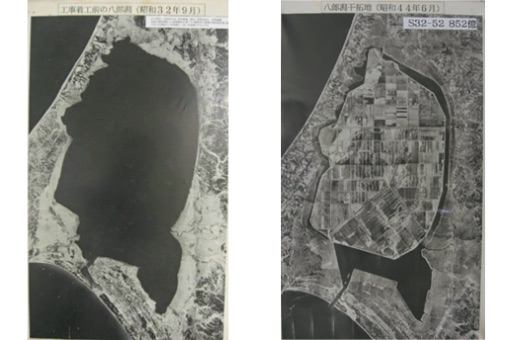
(Left): before construction, (Right): after construction
(source: website of MAFF)
9. Reducing disparities between rural and urban sectors and infrastructural improvement (1955~1964)
In 1956, the government declared that the country “no longer be termed postwar” in economic white papers, and the basic policy of Japan was to become a big economic power with increased national incomes. With prevailing high economic growth, environments surrounding Japanese agriculture markedly changed, including structural changes in food demand, emigration of agricultural labor forces to other sectors, an increase of side job farmers, sluggish increase of farm income and pressure of trade liberalization from foreign countries. At the time of expanding income disparity between primary industry and other sectors of the economy, the Agricultural Basic Act was enacted in 1961, making labor productivity increase the priority for land improvement works. In that year, agricultural land area reached a peak of 6.09 million ha. with a total population of about 90 million, and consumption of rice also peaked at 118 kg per person, showing the period of hunger was over.
The naming of land improvement project budgets was converted from the food production increase measures budget to the agricultural infrastructure improvement project budget in 1960. In 1961 a land reclamation pilot project was initiated to expand farm operation size, and in 1963 a land consolidation project was established to improve infrastructure and to consolidate farming plots, which promoted land consolidation with a standard of 30a-plots, provision of irrigation and drainage canals, associated construction works including farming roads and land replotting to increase labor productivity by farm mechanization. In 1966 a head-feeding combine harvester was developed and after 1965 rice transplanters were widely used. As such around 1970~80, multiple effects of land improvement, fertilizer, agricultural chemicals, machinery/facilities, extensions, and guidance favorably benefitting agricultural productivities, enormously increased labor productivity from 1,000 to 5,100 yen/10 hrs. and land productivity from 24 to 80 thousand yen/10 a. (both figures were real values from a 1980 base)7).
10. Surplus of rice and multiple uses of paddy fields (1965~)
With the progress of economic growth, a westernized diet has become popular, and the consumption of rice has declined sharply since 1965. A good harvest of rice was achieved in 1967 and 1968, resulting in the problem of rice surplus. At that time, the purchasing price of rice by the government was higher than the selling price, or under negative spread, and controlled by the national food control system, which expanded the budget deficit of the government. Then the government started a rice production control policy (or what is called Gentan Seisaku or acreage-reduction policy) by introducing such major measures as controlling new paddy field developments, setting the limit of government rice purchases, allocating acreage of non-rice crops, and paying subsidies for the encouragement of crop diversification8). In response to these changes, agricultural infrastructure improvement projects were modified in their systems/planning, so land reclamation was carried out not for paddy fields but upland crop development after 1969.
The period of high economic growth ended with the oil crisis in 1974, and Japan entered a period of stable growth. During this period, with the rise in the standard of living, people’s diets diversified, food self-sufficiency rates (particularly those of land intensive crops such as wheat, feed crops and beans) declined and agricultural land area decreased. Furthermore, the Soviet Union, faced with poor crops in 1973-74, purchased a large volume of grain from the international market, which then triggered a sharp increase in the price of grains, and the low food self-sufficiency rate of Japan became a major issue.
To cope with such situations, the cabinet approved to adopt a paddy field farming readjustment measure in 1978 as part of a production adjustment policy, and priority was placed on diversified uses of paddy fields as a means of overcoming surplus rice and increasing food self-sufficiency rates, and an implementation mechanism of “comprehensive land improvement projects” and “special drainage improvement projects” was introduced.
In the “Agricultural Land Use Promotion Act” of 1980, a legal basis to expand operation size by leasehold arrangement was facilitated, and at the same time technical examinations for promoting the large-scale plot size of paddy fields was undertaken to establish new infrastructure needs for responding to the liquidity of agricultural land. In 1987, paddy field use readjustment measures were succeeded by paddy field agriculture establishment measures, and a measure to allocate production adjustment areas through consultation between administrative and farmer groups, and a collective crop rotation system by regional farming organizations were gradually established.
11. Globalization and fostering personnel (Heisei Period)
In 1988, one year before entering the Heisei Period, Japan liberalized the market of beef and oranges after a Japan-US agricultural trade negotiation. In the midst of controversy over free trade and protection, the government adopted new directions for food, agriculture and rural areas (new policy) in 1992. This showed a basic policy of combining food imports and stocks while maintaining and enhancing domestic farming as much as possible to achieve food security. Land consolidation is a necessary condition for improving productivity, and the government created a large-scale land consolidation project (more than 1 ha. plot) in 1989 and a land consolidation promotion project for 21st–century-type paddy fields model in 1991, for which promotion subsidies were provided when consolidated plots were grouped into a series of production units. Following the new policy, a certified farmer system was established in 1993 to promote effective use of farmland and develop viable management bodies through the accumulation of farmland and its use to viable farmers.
With the agreement of the GATT Uruguay Round (UR) in 1993, rice import (minimum access rice) was approved. In the same year, Japan's rice production recorded a very bad harvest (crop yield index: 74) due to cold damage, and the rice supply was insufficient even with the release of a government rice reserve of 0.4 million tons, leading to the emergency import of rice (rice turmoil in Heisei Period). After 1994, to compensate for trade liberalization, UR related countermeasures have been implemented (total of 6 trillion 10 billion yen for 6 years, of which more than half (3 trillion 175 billion yen) was for land improvement works), which promote infrastructural development at an accelerated rate, including large scale paddy field plots and others.
During 2007 and 2008, the biofuel policy of the U.S. and poor harvests in Australia caused a sharp rise in international grain prices, which prompted riots in 20 countries due to social unrest, and export restrictions of food by 14 countries (Table 1). The Japanese government adopted the program of strengthening competitiveness in agriculture in 2016 to establish a strategic export framework and established infrastructural improvement projects in collaboration with Farmland Intermediary Management Institutions without the needs of cost sharing and consensus by farmers concerned. After all this, the government abolished the rice acreage reduction policy in 2018 after 40 years.
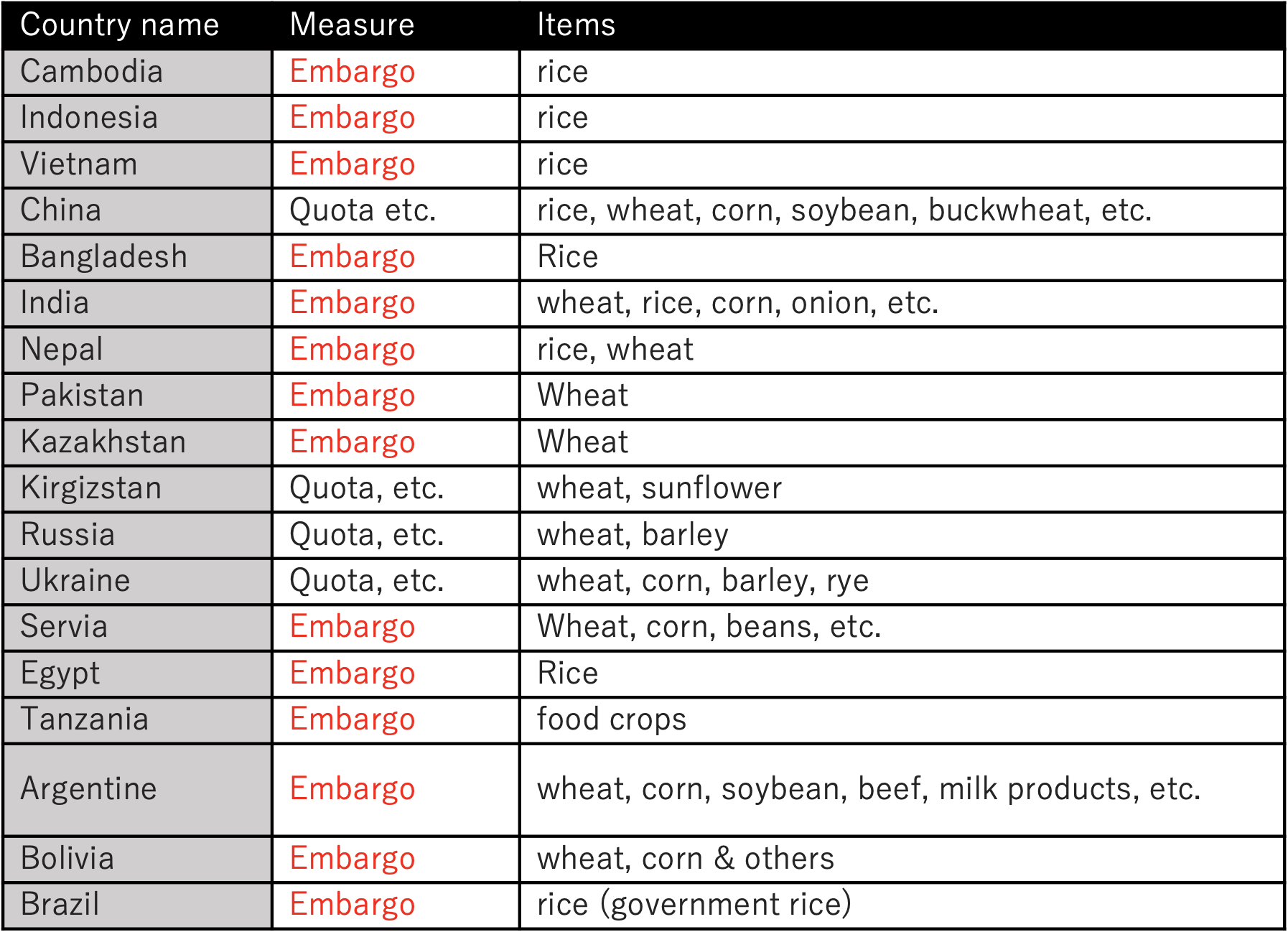
12. Heisei, Reiwa Periods and Further Ahead
Japan is now in a period of decreasing population, in particular an increase in the elderly and a decrease in the farmer population have been proceeding rapidly. In 2018, the total farmer population was 4.18 million, of which 43.5% were the elderly (more than 65 years old). Because of this, the structure of agriculture will change at an unprecedented rate over the next 10 to 20 years. Thus, fostering successors and readjusting land uses will be very important as an approach for future generations, and the policy measure for this will have to be land consolidation projects.
As shown in Figure 14, land consolidation projects have expanded standard plot sizes with the progress of farming technology. As of now, the application of smart agriculture that can enable ultra-labor- saving in farming, and the combining of GPS, communication, and data processing technologies, etc. is in a validation stage (Figure 15). In the near future, it is expected that wide applications of smart agriculture combined with land consolidation will foster management entities of a next-generation type. The most difficult issue in promoting land consolidation projects has always been consensus building, including project cost sharing among land owners. With the progress of technologies, tools such as databases linked with geographic information systems, investigations and surveys by drones and a future prediction simulation are more available, but a certain cost must always be borne. Based on such technological progress, not only the application of appropriate tools will be needed, but also steady efforts of consensus building at a grass roots level is inevitable. In addition, to smoothly form a consensus, a new approach of adjusting agrarian systems will be needed.
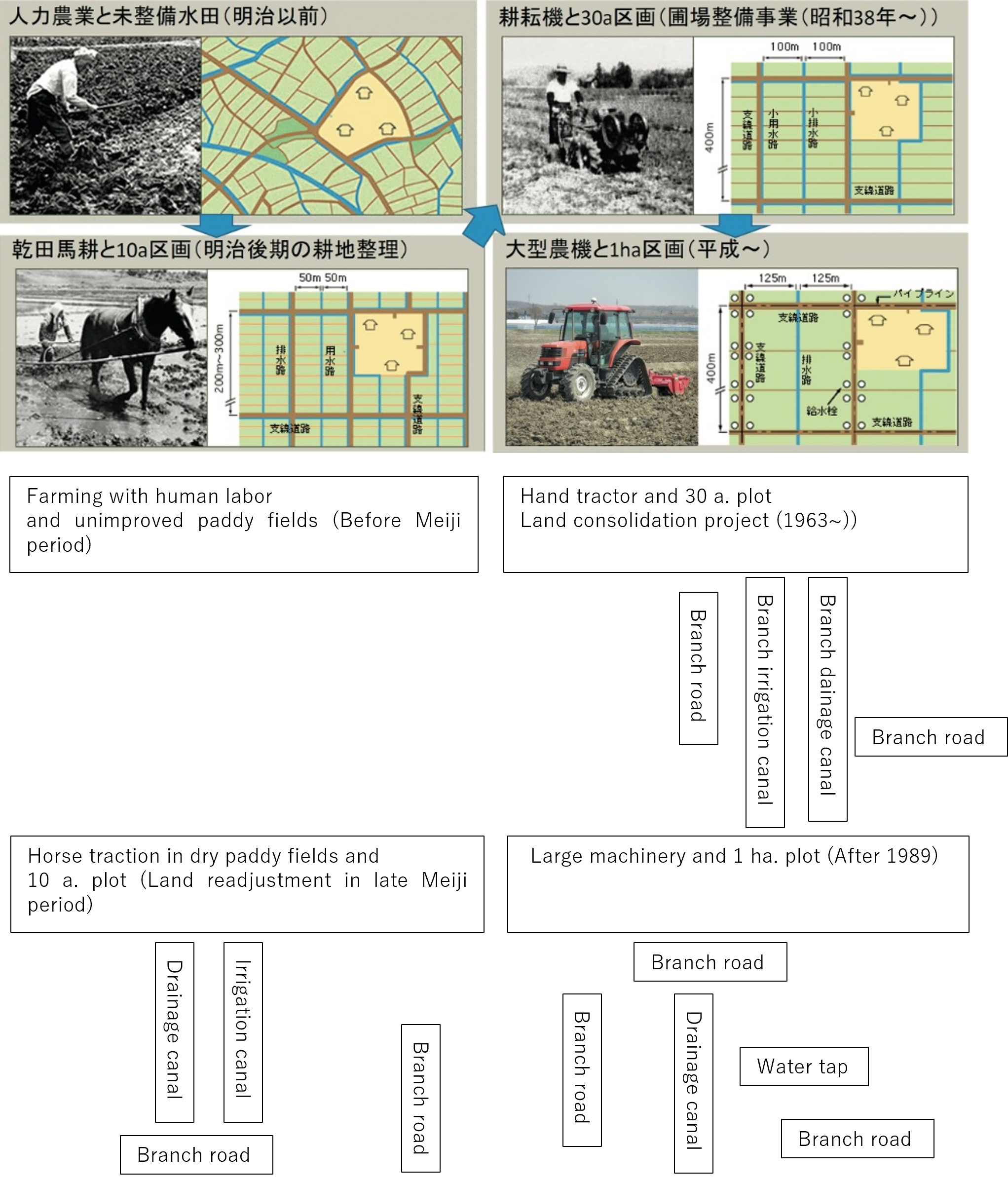
(Citation: ”Kokudo wo Souzoushita Hitobito” (People who created national land”) in Suidono Ishizue (Foundation of Water and Land))
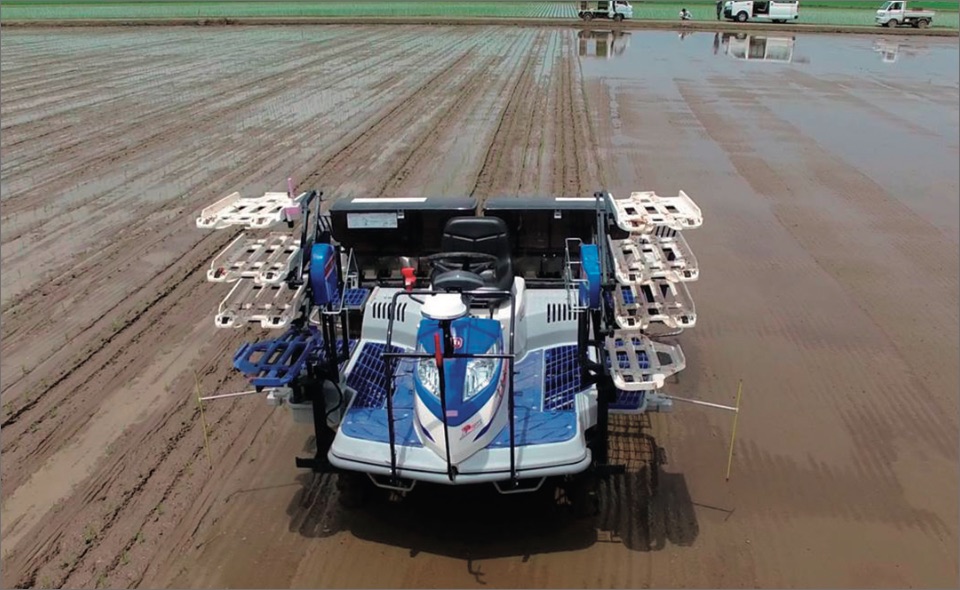
(Source: Website of MAFF)
In view of the world's future population trend, depletion of water resources, degradation of land, and uncertainties of natural disasters, etc., the fact that not only poor production but also market/distribution problems have caused starvation along with the risks of embargo during times of emergency must be kept in consideration. It is necessary to maintain domestic food production capacity rather than depend only on imports for food supply. To conserve farmland, the most fundamental center of existence since the dawn of history, and to hand over ever-lasting landscapes of Mizuho no Kuni (land of abundant rice plants) to next generations, are the responsibility and the driving force imposed on those who are living in the present.
Major References
1. Akira Takubo. Suiden to Zenpou Kouenfun. (Paddy Fields and Keyhole-shaped Tomb”). Nobunkyo Production, 2018.
2. Fusao Akiyama et.al. Shakai Keizaiteki Haikei tono Kanren kara mita Tenmei no Kikin to Ekibyou (A Study on the Famine, Epidemic, and Socio-economic backgrounds in the Tenmei period). Minzoku Eisei (Journal of the Japanese Society of Health and Human Ecology), Vol.43, No. 1.2, 1977
3. Isao Kikuchi. Famine-History of Starvation and Food in Japan. Shyueisha Shinsho, 2000.
4. Keizou Nonomura. Meijiki no Kindaiteki Tochikairyou Seido no Seiritu Katei to Genzai eno Shisa (Process of establishing modern land improvement system and implications to the present. Suido no Chi (Wisdom of water and Land) Vol. 86, No.9, 2018.
5. Youhei Sato and Junichi Hirota. Wagakuni Kouchiseirihou no Seiritu to Doitsu Kouchiseiri Housei no Eikyou (Influence of German Legislation on Enactment of the Arable Land Readjustment Act Japan). Journal of the Japanese Society of Irrigation, Drainage and Reclamation Engineering. Vol.67, No. 8, 1999.
6. Ministry of Agriculture and Forestry. Nourin Gyouseisi (Administrative History of Ministry of Agriculture and Forestry). 1957-1976
7. Fumin Kyoukai. Zude Miru Showa Nougyoushi (Agriculture History of Showa Period with Drawings). Nougyou to Keizai (Journal of Agriculture and Economy). Special issue of 55 anniversary, 1989.
8. Akihiro Nakawatari. Kome no Seisan Chousei Saku no Keii to Minaoshi Mondai (Issues on Processes and Revision for Rice Production Adjustment Measures), National Diet Library, Chousa to Jyouhou (Investigation and Information), Vol. 659, 2009.
9. Tokyo Zaidan. Uruguai Raundo to Nougyou Seisaku~Kako no Keiken kara Manabu~ (Uruguay Round and Agricultural Policy-Learning from Past Experiences-). February, 2014.
10. (General corporation) Tochi Kairyou Kensetu Kyoukai. Tokubetsu Kikaku Heisei Tochikairyou Kou (Special issue for consideration of land improvement in Heisei Period). Tochikairyou. No. 305, 2019.
11. Nogyodoboku Rekishi Kenkyukai. Daichi heno Kokuin (“Heritage of Land Development”), 1988.
12. Tochikairyou Jigyou ni kakawaru Hoseido no Hensen to sono Gaiyou (Transitions of legislation system of land improvement projects and its outlines). Materials of Prof. Ogata, Tottori University.
13. Nougyou Nouson no Rekishi (History agriculture and rural areas). Nougyou Nouson Seibi Ron Shiryo (Materials for agriculture and rural area development) of Kyoto University.
